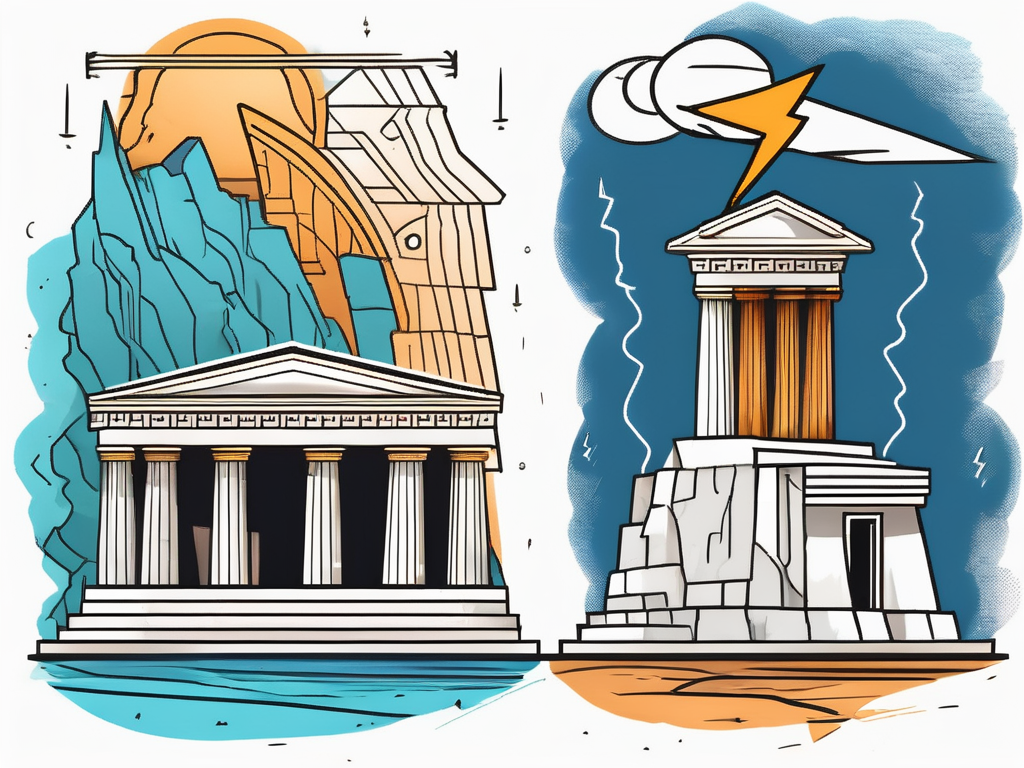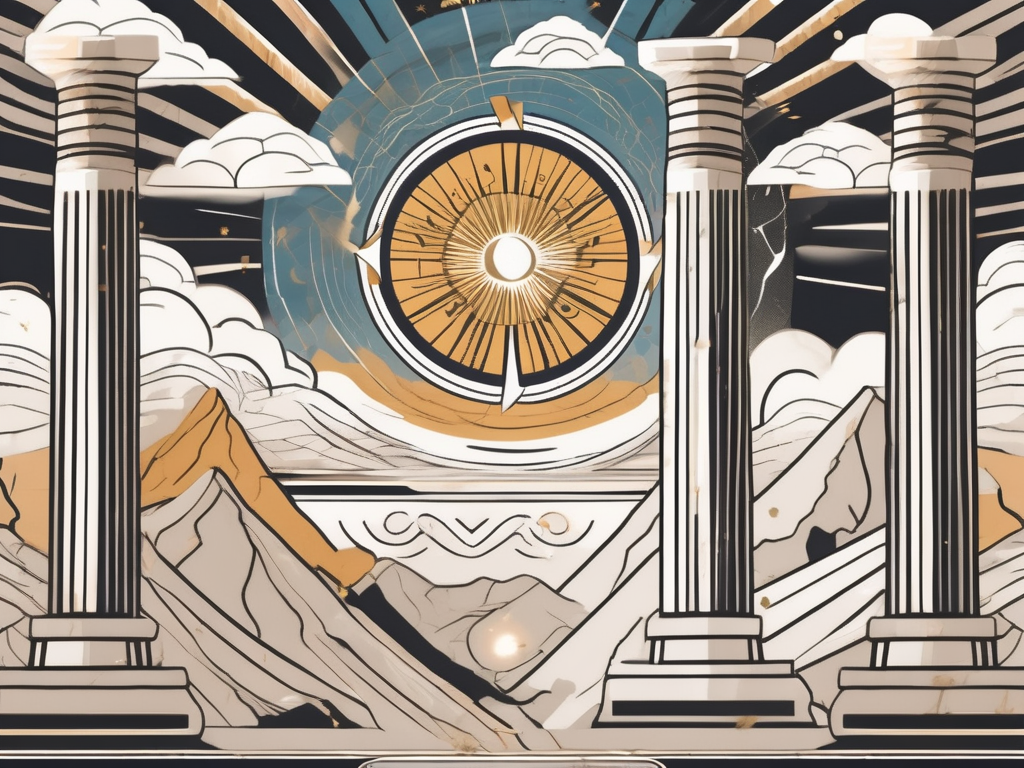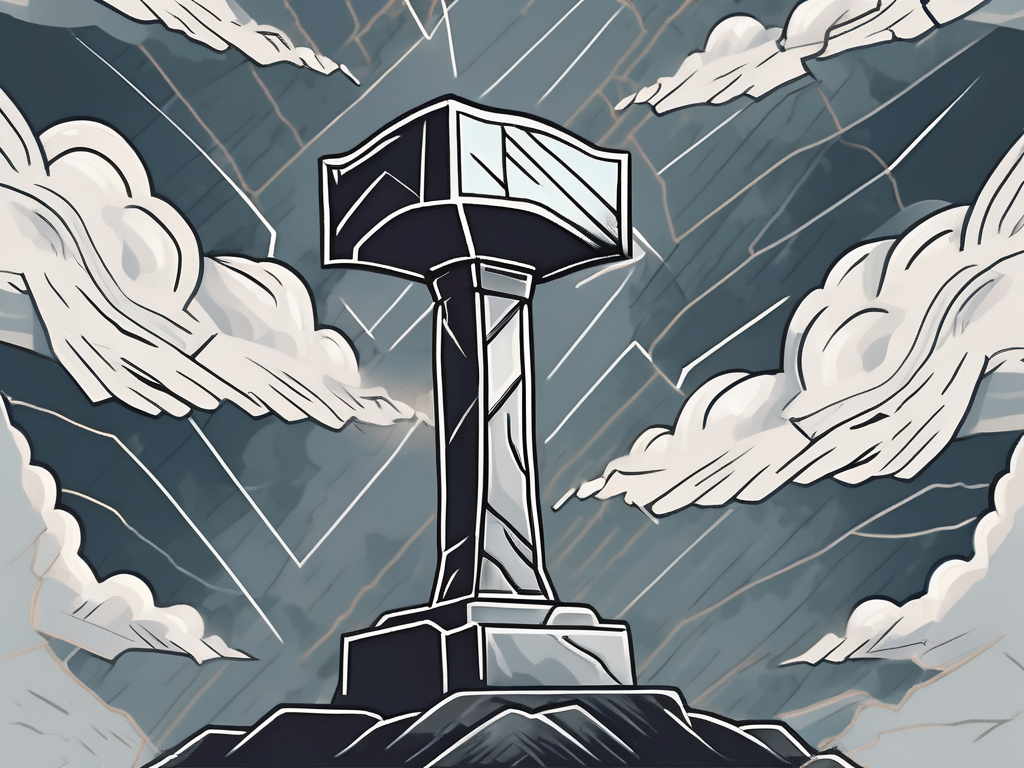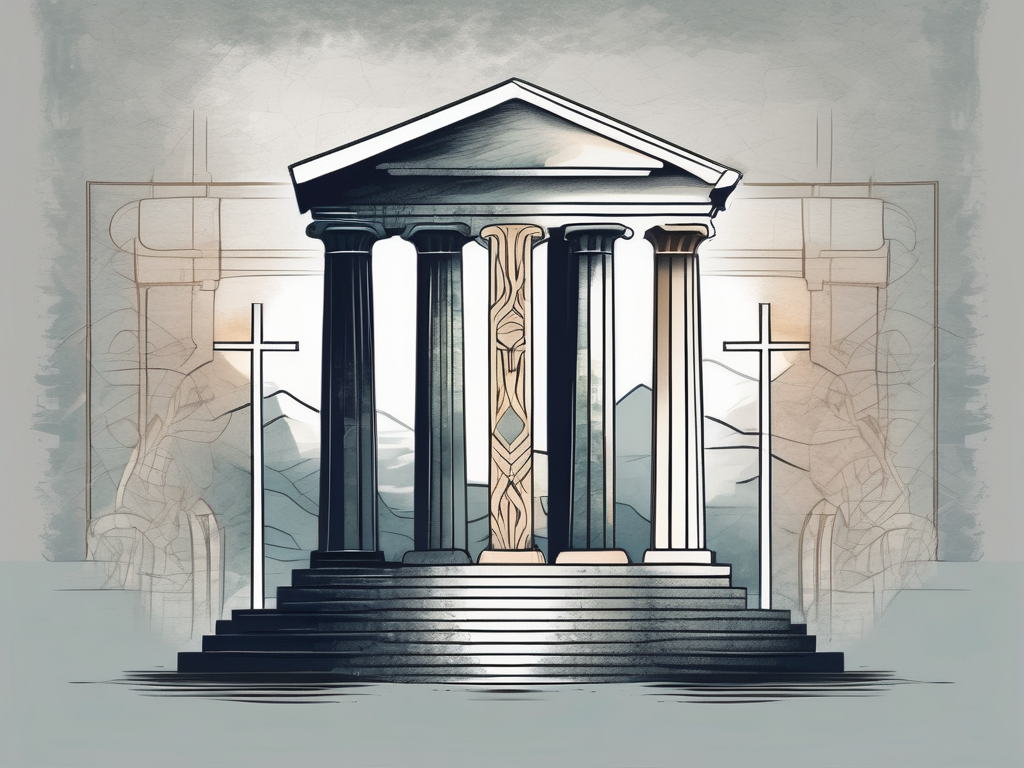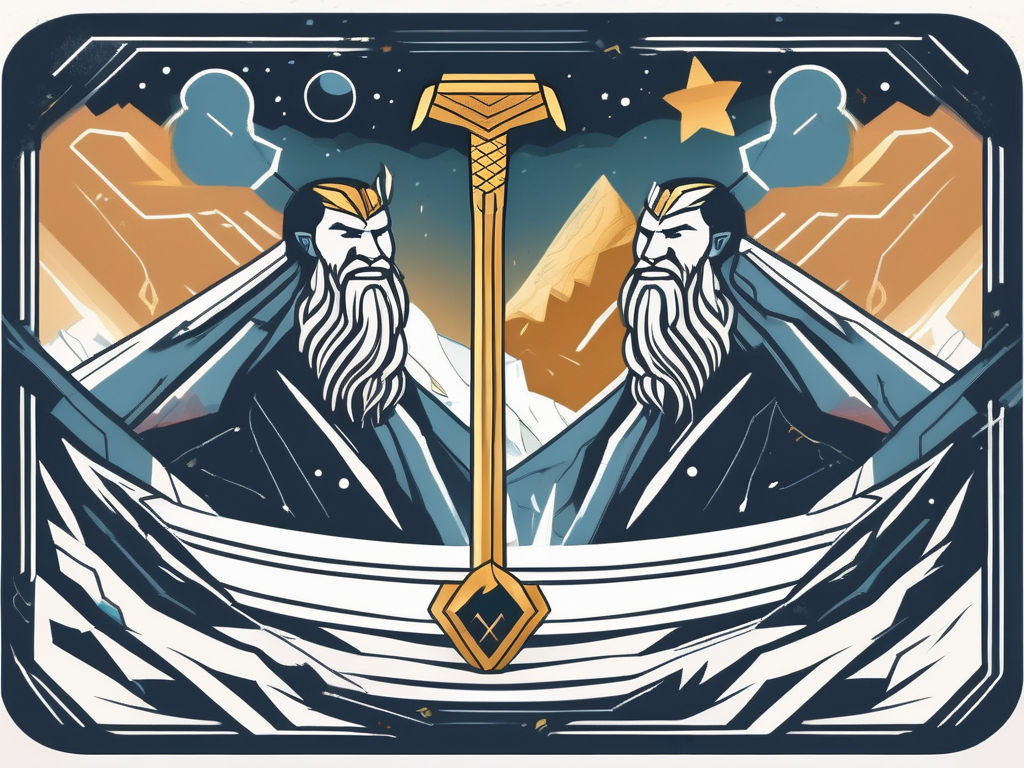Greek mythology and Roman mythology have long captivated the imaginations of people around the world. These ancient pantheons are rich with tales of gods and goddesses, heroes and monsters. While there are undoubtedly many similarities between the two mythologies, there are also notable differences that make each unique. In this article, we will delve into the world of Greek and Roman gods, examining their similarities, differences, and the lasting impact they have had on popular culture.
Understanding the Pantheon: An Introduction to Greek and Roman Gods
Before we can begin exploring the specific differences and similarities between Greek and Roman gods, it is important to develop a foundational understanding of their respective pantheons. In both mythologies, gods and goddesses were believed to possess great power and influence over various aspects of the world.
The Greek pantheon, with its rich and complex mythology, captivates the imagination with its diverse cast of characters. At the helm of this divine hierarchy is Zeus, the mighty king of the gods. With his thunderbolts and commanding presence, Zeus symbolizes not only power but also leadership and justice. His wife and sister, Hera, stands as the goddess of marriage and family, embodying the ideals of unity and companionship.
Among the many gods and goddesses that populate the Greek pantheon, Poseidon, the god of the sea, holds a prominent position. With his trident in hand, he commands the vast oceans and represents the unpredictable yet awe-inspiring forces of nature. Athena, on the other hand, is the goddess of wisdom and warfare, blending intellectual prowess with strategic brilliance.
These examples merely scratch the surface of the Greek pantheon, which is teeming with a multitude of deities, each with their own unique role and story. From Apollo, the god of music and poetry, to Aphrodite, the goddess of love and beauty, the Greek gods and goddesses embody various aspects of human experience and emotion.
The Roman Pantheon: Key Figures and Roles
The Roman pantheon, while heavily influenced by Greek mythology, also boasts its own distinctive set of gods and goddesses. The Romans, known for their assimilation of different cultures, adopted many of the Greek gods, albeit with some modifications to suit their own beliefs and values.
Jupiter, the Roman equivalent of Zeus, assumes a central role in the Roman pantheon. As the king of the gods, he wields thunderbolts and exudes authority, much like his Greek counterpart. Juno, the Roman equivalent of Hera, retains her position as the goddess of marriage and family, emphasizing the importance of these institutions in Roman society.
However, the Romans also introduced their own deities into the pantheon, reflecting their unique cultural priorities. Mars, the god of war, exemplifies the Roman focus on military prowess and strategic thinking. With his spear and shield, Mars embodies the valor and strength that were highly esteemed in Roman society. Minerva, the goddess of wisdom, serves as a counterpart to Athena, but with a distinct Roman flavor. She embodies not only intellectual acumen but also the practical wisdom necessary for governance and civilization.
Just as the Greek pantheon is a tapestry of gods and goddesses, the Roman pantheon is a vibrant mosaic of divine beings, each with their own attributes and significance. From Venus, the goddess of love and beauty, to Mercury, the messenger of the gods, the Roman pantheon reflects the multifaceted nature of Roman culture and its reverence for the divine.
The Gods of Olympus vs The Gods of Rome: A Comparative Analysis
Now that we have a basic understanding of the Greek and Roman pantheons, let us dive deeper into the ways in which these gods and goddesses differ from each other.
Power and Influence: How the Gods Ruled
While both Greek and Roman gods wielded immense power, their methods of ruling differed slightly. In Greek mythology, the gods were often described as capricious and unpredictable, intervening in human affairs whenever they pleased. This resulted in a more chaotic and unpredictable world where mortals had to navigate the whims of the gods.
On the other hand, Roman gods were portrayed as more structured and law-abiding, mirroring the organized nature of Roman society. They were seen as protectors and guardians, ensuring the stability and well-being of the Roman Empire.
Iconography and Symbolism: Visual Representations of the Gods
The gods of both pantheons were often depicted in art and sculpture, each with their own unique symbols and attributes. Greek gods were typically depicted in idealized human forms, emphasizing their beauty and divine qualities. Symbolism played a crucial role in Greek art, with each god having specific objects or animals associated with them. For example, Hermes, the messenger of the gods, was often depicted with winged sandals and a caduceus.
Roman depictions of gods, on the other hand, were more realistic and focused on capturing the true essence of the individual. They were often portrayed in a more stoic and serious manner, reflecting the Roman emphasis on discipline and order.
The Intersection of Greek and Roman Mythology
While there are undoubtedly differences between Greek and Roman mythology, it is important to note that the two pantheons intersected in various ways. The Romans not only adopted many Greek gods, but they also incorporated their myths and legends into their own culture.
Shared Gods and Their Stories
Many gods and goddesses were worshipped by both the Greeks and Romans, albeit with different names. As previously mentioned, Zeus became Jupiter, Hera became Juno, and so on. The stories associated with these gods and goddesses also found their way into Roman mythology, albeit with slight modifications to adapt to Roman culture.
For example, the tale of the Trojan War, which was central to Greek mythology, was also incorporated into Roman mythology under the name “The Aeneid.” This epic poem tells the story of Aeneas, a Trojan hero who eventually founded Rome.
Unique Gods and Their Significance
While many gods and goddesses were shared between the Greek and Roman pantheons, each mythology also had its own unique deities. These gods often held significant cultural and societal importance.
In Greek mythology, Dionysus was the god of wine and fertility, representing the celebration of life and the pursuit of pleasure. In Roman mythology, Bacchus served a similar role but was also associated with excess and indulgence. These gods played a crucial role in religious and social festivals, reminding the ancient Greeks and Romans of the importance of balance and enjoyment in life.
Cultural Impact of Greek and Roman Gods
The gods of ancient Greece and Rome have had a lasting impact on various aspects of human culture. From literature to art, their influence can still be felt today.
Influence on Literature and Art
Greek and Roman mythology provided a rich source of inspiration for countless works of literature and art throughout history. The stories of Hercules, Achilles, and Odysseus, among others, have been told and retold in various forms, from epic poems to novels and plays.
The intricate relationships, dramatic conflicts, and moral lessons of these myths continue to captivate audiences around the world. Similarly, the gods and goddesses of both pantheons have been depicted in countless paintings, sculptures, and other forms of visual art.
Impact on Society and Morality
Ancient Greek and Roman society was deeply religious, with the gods permeating all aspects of daily life. The myths and stories surrounding these gods provided a moral framework for society, shaping ideas about what was right and wrong, good and evil.
Moral values such as honor, bravery, and loyalty were often derived from the actions and teachings of the gods in these stories. They served as examples to be emulated or avoided, influencing the behavior and beliefs of ancient Greeks and Romans.
The Evolution of Worship: From Ancient Times to Modern Day
As with any religion, the worship of Greek and Roman gods has evolved over time. Ancient practices and rituals have given way to modern interpretations and beliefs.
Ancient Practices and Rituals
In ancient times, worship of the gods involved elaborate rituals and ceremonies. Temples were built and offerings made to appease the gods and seek their favor. Festivals celebrating specific gods were held throughout the year, bringing communities together in shared reverence.
Sacrifices, prayers, and processions were common occurrences, all aimed at maintaining a harmonious relationship between the mortal realm and the divine.
Modern Interpretations and Beliefs
Today, the worship of Greek and Roman gods has largely transitioned into the realm of mythology and folklore. While there are still practitioners of ancient religions such as Hellenism and Roman Reconstructionism, these beliefs have become niche and are not widely practiced.
The gods and goddesses of ancient Greece and Rome now primarily exist as characters in literature, movies, and popular culture. Their stories continue to be retold and adapted, keeping their memory alive in the modern world.
In Conclusion
Greek and Roman mythology offer us a glimpse into the beliefs and values of two ancient civilizations. While there are differences between the two mythologies, they share common themes, gods, and stories that have captivated generations of people. The enduring impact of these gods can be seen in literature, art, and the way we understand and interpret the world around us. The gods of Olympus and the gods of Rome may no longer be worshipped as they once were, but their legacy lives on in the hearts and minds of those who continue to be fascinated by their timeless stories.
